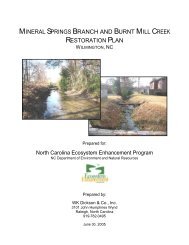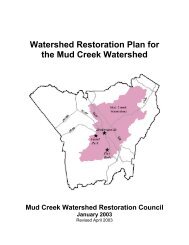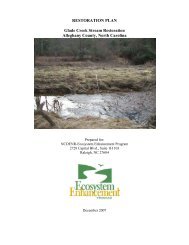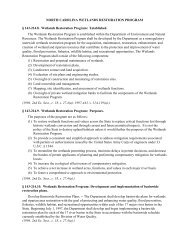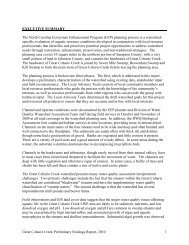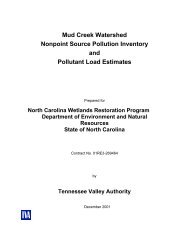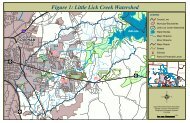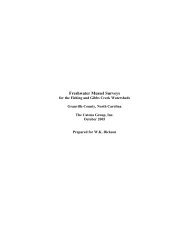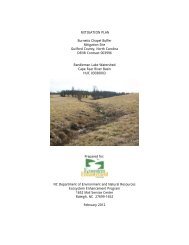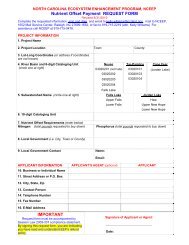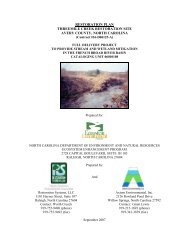Watershed Restoration Plan for the White Oak River Basin i
Watershed Restoration Plan for the White Oak River Basin i
Watershed Restoration Plan for the White Oak River Basin i
Create successful ePaper yourself
Turn your PDF publications into a flip-book with our unique Google optimized e-Paper software.
Table 4.1: Summary in<strong>for</strong>mation <strong>for</strong> Targeted Local <strong>Watershed</strong>s in <strong>White</strong> <strong>Oak</strong> <strong>River</strong> <strong>Basin</strong> Subbasin 01<br />
TARGETED LOCAL<br />
WATERSHED<br />
UPPER WHITE OAK RIVER &<br />
GIBSON BRANCH<br />
WEBB CR., HOLLAND MILL CR.<br />
& WH.ITE OAK<br />
PETTIFORD CREEK & WHITE<br />
OAK MAINSTEM<br />
QUEEN CREEK & PARROT<br />
SWAMP<br />
County Onslow, Jones Onslow Carteret Onslow<br />
14-digit Hydrologic Unit # 030201060 10010 030201060 20010 030201060 20030 030201060 20060<br />
Land Area [sq. mi.s] 68.0 21.7 24.5 35.3<br />
Impaired Waters<br />
[NS or PS use support rating] 1<br />
Possible Causes/Sources of<br />
Degradation 2<br />
none<br />
nutrient loading, channelization,<br />
habitat degradation; stormwater<br />
runoff from urban, agric. [NPS]<br />
Yes: >1,000 acres of <strong>the</strong> <strong>White</strong> <strong>Oak</strong><br />
mainstem [estuary]<br />
fecal coli<strong>for</strong>m, nutrients, sediments<br />
in urban & agric. stormwater runoff<br />
[NPS]; riparian clearing<br />
Yes: 270+ acres of SA waters, incl.<br />
Bay at mouth of Petti<strong>for</strong>d Crk.<br />
fecal coli<strong>for</strong>m, sediments, and nutrient<br />
inputs from subdivisions, ag. & urban<br />
runoff, <strong>for</strong>est clearing, wildlife [NPS]<br />
Yes: 800+ acres of SA waters<br />
fecal coli<strong>for</strong>m, sediments, and<br />
nutrient inputs from subdivisions, ag.<br />
& urban runoff, <strong>for</strong>est clearing,<br />
wildlife [NPS]<br />
Land Cover - % Cleared 13% 36% 11% 18%<br />
Land Cover - % Developed 0 0 2% 5%<br />
Land Cover - % Forested 87% 64% 86% 76%<br />
Shellfishing Waters 3 No Yes Yes Yes<br />
NSW, HQW or ORW Waters 4 No HQW [SA waters] HQW [SA waters] HQW [SA waters]<br />
Aquatic Natural Heritage<br />
Element(s) 5 Yes Yes Yes Yes<br />
Current 319, CWMTF, or NCWRP<br />
Projects<br />
<strong>Plan</strong>ned [NCCF] Yes Yes [319; plus WOR Adv. Brd.]<br />
Yes [Swansboro CWMTF; NCWRP<br />
Hammocks Beach SP]<br />
1 See Section 2 <strong>for</strong> a brief explanation of use impairment. See <strong>the</strong> DWQ <strong>White</strong> <strong>Oak</strong> <strong>River</strong> <strong>Basin</strong>wide Water Quality <strong>Plan</strong> <strong>for</strong> a more complete explanation of DWQ stream classifications & standards<br />
and use support ratings.<br />
2 In<strong>for</strong>mation on possible causes [e.g., habitat degradation, sediment & nutrient inputs] and sources [e.g., non-point source runoff from agricultural/logging areas] of water quality degradation and use<br />
support impairment is obtained primarily from <strong>the</strong> DWQ <strong>Basin</strong>wide Water Quality <strong>Plan</strong> and <strong>Basin</strong>wide Assessment Report <strong>for</strong> <strong>the</strong> <strong>White</strong> <strong>Oak</strong> basin. Habitat degradation includes instream<br />
sedimentation, bank erosion, channelization, lack of riparian vegetation, loss of pools/riffles, removal of woody habitat, and streambed scour.<br />
3 Shellfishing Waters are DWQ Class SA waters, whose best use is commercial shellfish harvesting. All SA waters are, by definition, also considered to be High Quality Waters [HQW], which<br />
include critical habitat areas or primary nursery areas..<br />
4 NSW = nutrient sensitive waters. ORW = outstanding resource waters.<br />
5 Aquatic Natural Heritage elements are special species, habitats, or community types identified by <strong>the</strong> NC Natural Heritage Program and that occur, or spend some portion of <strong>the</strong>ir life cycle, in<br />
wetlands, streams, riparian areas, or estuarine waters.<br />
<strong>Watershed</strong> <strong>Restoration</strong> <strong>Plan</strong> <strong>for</strong> <strong>the</strong> <strong>White</strong> <strong>Oak</strong> <strong>River</strong> <strong>Basin</strong> 21




